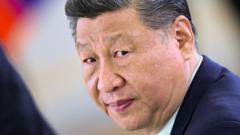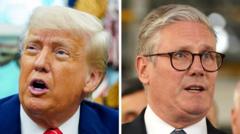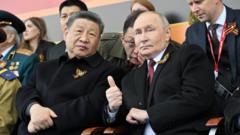The announcement of substantial tariffs by President Trump on numerous countries has deepened the divide between the United States and its allied nations, while also altering the global economic landscape.
Trump's Tariff Announcement Creates Tensions with Global Allies

Trump's Tariff Announcement Creates Tensions with Global Allies
President Trump’s new tariff policy threatens to escalate trade tensions with key U.S. allies and reshape global trade dynamics.
April 2, 2025, 5:41 p.m. ET
In a sweeping move, President Trump unveiled a series of tariffs on various global trading partners, a decision that is likely to strain relations with some of America's closest allies and trigger extensive shifts in international trade. Under the announcement made on Wednesday, the president’s “reciprocal” tariff strategy encompasses a broad spectrum of nations, imposing a heavy 20 percent tariff on the European Union and an additional 34 percent on China, compounding the current tariffs in place.
Eswar Prasad, an economics professor at Cornell University's Dyson School, expressed concern over the measure, stating, “The scale of these tariffs underscores a significant departure from free trade principles and signals the beginning of a new protectionist wave that may have widespread ramifications.”
Notably, Canada and Mexico, critical trading partners for the U.S., are excluded from the new tariffs, retaining only the tariffs set previously concerning vehicles, steel, and aluminum, among others. The proposed tariffs will impose a 10 percent baseline tariff on all other countries, coupled with extra charges relative to the tariffs those countries impose on U.S. goods and perceived unfair trade barriers.
This declaration marks the latest development in an ongoing trade conflict that has been intensifying in recent weeks. President Trump has already executed tariffs on steel and aluminum, disclosed impending car tariffs, and threatened countermeasures against European wines and spirits, alongside varying levels of tariffs on both Canada and China.
This evolving scenario signals a notable shift in U.S. trade policy that is expected to generate significant impact on global economic relations as stakeholders brace for potential repercussions.
In a sweeping move, President Trump unveiled a series of tariffs on various global trading partners, a decision that is likely to strain relations with some of America's closest allies and trigger extensive shifts in international trade. Under the announcement made on Wednesday, the president’s “reciprocal” tariff strategy encompasses a broad spectrum of nations, imposing a heavy 20 percent tariff on the European Union and an additional 34 percent on China, compounding the current tariffs in place.
Eswar Prasad, an economics professor at Cornell University's Dyson School, expressed concern over the measure, stating, “The scale of these tariffs underscores a significant departure from free trade principles and signals the beginning of a new protectionist wave that may have widespread ramifications.”
Notably, Canada and Mexico, critical trading partners for the U.S., are excluded from the new tariffs, retaining only the tariffs set previously concerning vehicles, steel, and aluminum, among others. The proposed tariffs will impose a 10 percent baseline tariff on all other countries, coupled with extra charges relative to the tariffs those countries impose on U.S. goods and perceived unfair trade barriers.
This declaration marks the latest development in an ongoing trade conflict that has been intensifying in recent weeks. President Trump has already executed tariffs on steel and aluminum, disclosed impending car tariffs, and threatened countermeasures against European wines and spirits, alongside varying levels of tariffs on both Canada and China.
This evolving scenario signals a notable shift in U.S. trade policy that is expected to generate significant impact on global economic relations as stakeholders brace for potential repercussions.





















